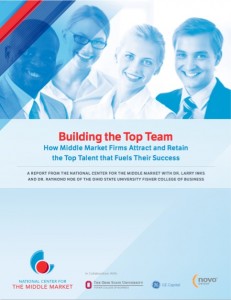7 Best Practices for Creating a Strong Employer Brand
For a company to be successful, having the right people on the team is essential. This is especially true for top talent – those in senior leadership positions or potential candidates who could backfill those positions. Jim Collins, author of the best-selling book Good to Great, said it best when he stated that great companies “have the right people on the bus”.
This topic is particularly relevant for companies in the middle market, those with annual revenues between $10 million and $1 billion.
 In a recent article published by the American Marketing Association (AMA), the question was raised about the amount of money lost by companies that do not have an employer brand. The AMA article states that only 25% of middle market companies have a strong employer brand, as well as a strong Employee Value Proposition (EVP). The financial impact of this issue is significant.
In a recent article published by the American Marketing Association (AMA), the question was raised about the amount of money lost by companies that do not have an employer brand. The AMA article states that only 25% of middle market companies have a strong employer brand, as well as a strong Employee Value Proposition (EVP). The financial impact of this issue is significant.
A strong employer brand translates into 2 ½ times higher growth.
The AMA article highlights research stating that those with strong employer brands saw revenues increase by 20%, while those with weak employer brands only grew by 8%.
What exactly is meant by an employer brand?
Hudson RPO (a global talent solutions company) defines an employer brand as follows:
The perception of the organization as a great place to work by both current and potential employees.
To me, this is a solid definition where the focus is on the employer-employee relationship and why anyone would want to work for a particular organization. Having a strong employer brand not only attracts quality top talent but also the right people for the entire company.
But I see many additional benefits of having a strong employer brand, including:
- It differentiates the company in a crowded marketplace.
- It attracts better investors and potential suppliers.
- It creates long-term competitive advantage.
As AMA highlights, the companies that benefit the most from having a strong employer brand are middle market companies – those that likely struggle with name recognition or reputation compared to their larger competitors.
Middle Market Research Report
 The findings of a 2015 research report, by The National Center for the Middle Market and the Ohio State University, clearly support the need for a strong employer brand:
The findings of a 2015 research report, by The National Center for the Middle Market and the Ohio State University, clearly support the need for a strong employer brand:
- A unique employer brand and persuasive employee value proposition can give middle market firms the edge they need to secure top talent. Middle market firms may not be able to compete with their larger rivals in terms of name recognition or compensation. But firms with a solid reputation that offer unique benefits and rewards experience greater success in securing top talent.
- Companies with an established employer brand and strong employee value proposition outperform their peers. Middle market firms that have strong employer brands and EVPs are more likely to report improved company performance and higher revenue and employment growth than firms with less established brands and EVPs.
However, the authors of the Middle Market Research Report suggest it doesn’t have to cost any money to create an employer brand. I disagree completely. The ONLY way to create an employer brand is purposeful investment. As every company has many competing agendas and priorities, this is something that can’t be left to chance.
Creating an employer brand is no different that any other kind of brand development. It requires good strategic planning and defined investments. And just like other forms of branding, such investments provide significant benefits, both in the short-term (hiring the right talent) and long-term (financial gains and growth). On this point the authors and I agree.
So how to create a strong employer brand?
Best Practices for Creating a Strong Employer Brand
The Middle Market Research Report outlines six best practices to establish a strong employer brand.
- Recognize that all firms have employer brands, whether they know it or not. Every company has a reputation. Just ask current and previous employees. The point is to be open to seeing what exists already, both the good and not-so-good.
- Brainstorm ways to strengthen and differentiate the brand and EVP. This is about leveraging existing strengths (and minimizing weaknesses) by tapping into the talent and knowledge of current employees.
- Create an authentic and genuine brand and EVP. It’s essential that the brand is an accurate reflection of why people work for the company. Nothing trendy. It must be truthful, positive, and future-focused.
- Involve the marketing department in the process. Not only is branding their expertise, marketing can help differentiate the brand and articulate it in a meaningful way. They can also ensure alignment with all external communication and branding efforts.
- Clearly articulate the company’s EVP. Documenting and communicating the company’s mission, vision, values and culture (online and offline) supports recruitment efforts and reminds existing employees why they also choose to work there.
- Make use of the employer brand and EVP in recruiting efforts. Be proactive in communicating the employer brand (online and offline) to create awareness in places with the highest probability of recruiting the “right” people.
I would add an additional best practice:
- Identify and define differentiating values that create competitive advantage. When determining a company’s core values, it’s ok to include 1 or 2 values from the list of 17 Common Values, but it’s critical for companies to also identify at least one differentiating value – the value(s) that highlights what sets the company apart from competitors and everyone else in the same industry. Collectively, these values are THE REASON why the right employees choose to work for the company.
While these best practices are recommended for middle market companies, they easily apply to companies of all sizes, industries, B2C and B2B, public and private, and even across geography.
Bottom line: A well-defined employer brand will help attract and retain the right people, which will ultimately lead to healthier growth and a stronger bottom line.
—————————–
Does your company have a strong employer brand? If not, why not?









